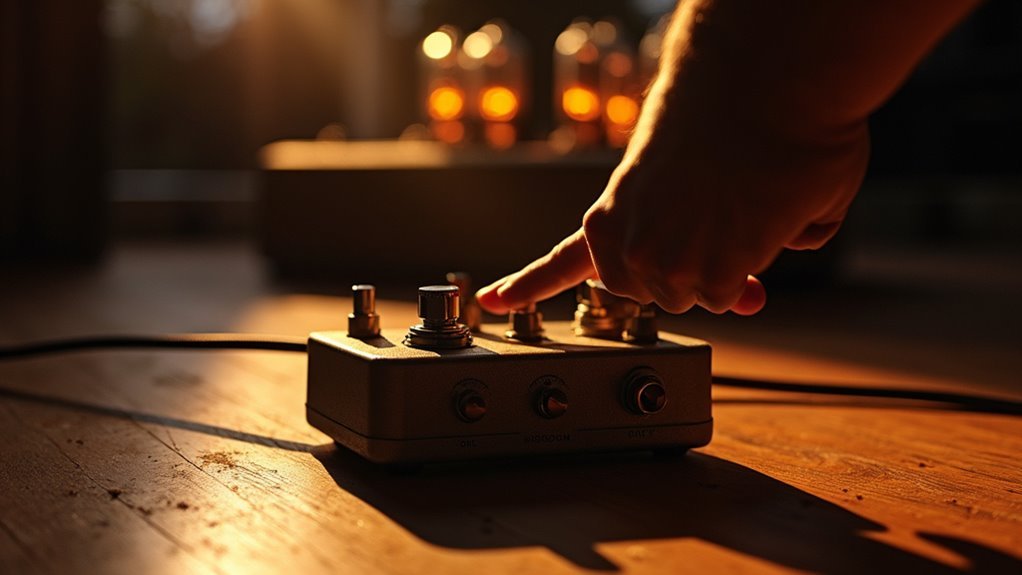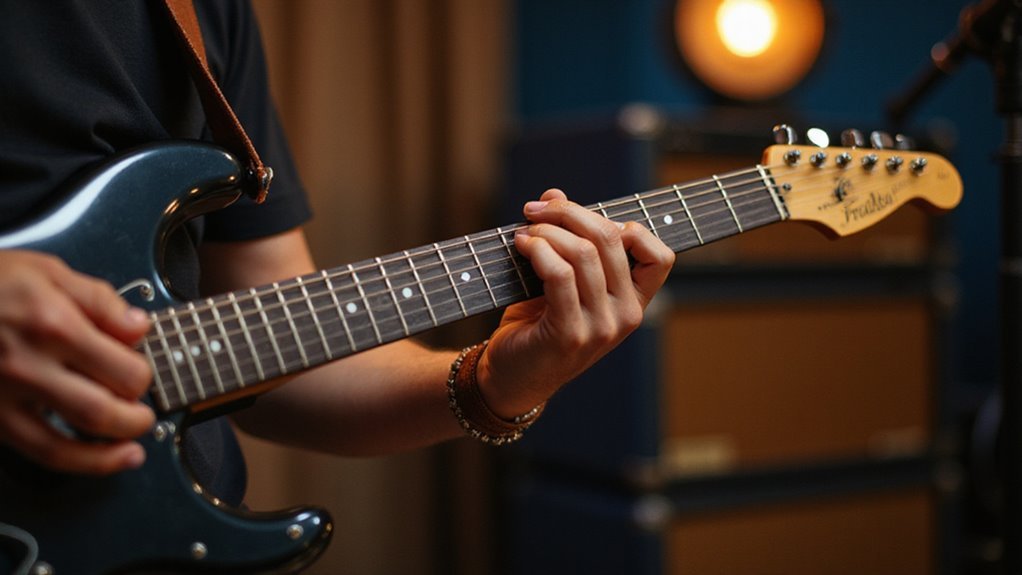I remember watching Pete Thorn coax this monstrous yet articulate tone from a simple Boss DS-1 that completely transformed my understanding of distortion. You’d be surprised how many guitarists buy pedal after pedal, chasing a sound that might actually be achievable with what they already own. It’s rarely about having the most expensive boutique distortion—it’s about truly mastering the one you’ve got. Maybe it’s time to stop the endless gear hunt and start the real work.
Finding Your Perfect Gain Sweet Spot

When it comes to mastering distortion pedals, finding your perfect gain sweet spot is perhaps the most essential first step in your journey.
You’ll want to start with your gain around mid-range, which gives you that balanced tone without muddying your guitar’s natural voice.
I’ve found that testing your gain at different volumes makes a huge difference.
What sounds great in your bedroom might fall flat on stage. Trust me, we’ve all been there!
Essential Drive and Tone Controls Demystified

Two essential controls that often confuse new guitarists are drive and tone—yet understanding them transforms your distortion capabilities.
I think many players overthink these knobs when they’re actually quite intuitive once you try them out.
Here’s what you need to know:
- Drive controls distortion intensity – higher settings for metal, lower for blues.
- Tone shapes brightness – clockwise for cutting through a mix, counterclockwise for warmth.
- These controls interact – the perfect drive setting might need tone adjustments to sound right.
Perhaps experiment with both simultaneously, rather than one at a time.
You’ll find your sweet spot faster.
Dynamic Playing Techniques for Expressive Distortion

Mastering those basic controls is just the beginning—it’s your actual playing techniques that truly bring distortion pedals to life.
Palm muting, for instance, can transform your sound from wild and wooly to tight and percussive with just a slight adjustment of your picking hand.
When you’re playing with high gain, I think varying your attack is essential.
Try lightening your touch for cleaner passages, then dig in for those power moments.
Perhaps the most overlooked technique is simply using your guitar’s volume knob—rolling it back slightly cleans up your tone without losing that edge we all crave.
Strategic Pedal Placement in Your Signal Chain
The position of your distortion pedal in your signal chain might be the most overlooked factor in achieving your ideal tone.
I’ve found that where you place it relative to other effects can dramatically change how everything interacts.
Perhaps it’s worth experimenting with different arrangements to find what works for your specific setup.
For best results, try these placements:
- Before modulation effects for clearer, more defined distortion
- After compression to maintain dynamics while adding grit
- Before delay/reverb to keep your ambient effects cleaner
Combining Distortion With Other Effects for Depth
While distortion on its own can transform your guitar sound, combining it with other effects opens up an entirely new world of tonal possibilities.
Think about adding delay to your distorted tone—it creates this amazing spatial depth that’s perfect for solos. I find that a touch of reverb can really make those heavy riffs breathe a bit more.
Compression is another game-changer when paired with distortion. It’ll smooth out your playing and give you that sustain that just goes on forever.
Perhaps try an EQ after your distortion to shape exactly which frequencies cut through. We’re all looking for that signature sound, right?
Genre-Specific Distortion Settings and Applications
Different genres demand their own unique distortion flavors, and knowing how to dial in those specific tones can truly elevate your playing.
Every genre speaks its own distortion language – mastering these tonal dialects transforms good playing into great performance.
I think finding that sweet spot for your preferred style makes all the difference in connecting with your audience.
- For blues and classic rock, try lower gain settings (around 9-11 o’clock) with moderate tone adjustments to capture that warm, vintage crunch.
- Metal players should max out tone and push gain past noon, perhaps incorporating palm muting for tight, aggressive rhythms.
- Alternative and indie genres benefit from mid-range gain with slight EQ adjustments to create distinctive textures.
Fine-Tuning Your Distortion With EQ and Compression
Fine-tuning your distortion pedal is where the magic really happens, especially when you add EQ and compression to the mix.
These tools take your tone from good to exceptional, letting your personality shine through every note.
Your EQ shapes the frequency response, perhaps cutting those muddy lows or boosting mids that help you cut through the band mix.
I think most players overlook how essential this step is.
Compression, meanwhile, adds that sustained character we all crave, smoothing your playing while maintaining clarity.
Try positioning your EQ after distortion—it’s not a rule, but I’ve found it gives cleaner control over your final sound.
Frequently Asked Questions
How Do Temperature and Humidity Affect Distortion Pedal Performance?
Temperature and humidity can warp your pedal’s components and circuits. Extreme cold affects battery life while moisture creates unwanted noise. You’ll get consistent performance by storing pedals in moderate conditions.
Can Distortion Pedals Damage Amplifiers or Speakers Over Time?
No, your distortion pedals won’t damage amps or speakers when used properly. Just keep volume levels reasonable and avoid extreme settings that could cause excessive signal clipping or overheating.
How Often Should Distortion Pedal Batteries Be Replaced?
You should replace your distortion pedal batteries every 4-6 months if used regularly. For less frequent players, check them when you notice tone changes or reduced volume output.
Are Boutique Distortion Pedals Worth the Higher Price Tag?
Like finding your guitar’s soulmate, boutique distortion pedals often justify their price through superior components, hand-wiring, and unique tonal character. You’ll appreciate their enhanced responsiveness and distinctive sound signature.
Can Distortion Pedals Be Effectively Used With Acoustic Guitars?
Yes, you can use distortion pedals with acoustic guitars, but you’ll need a pickup or microphone. They’re great for creating unique textures while maintaining your acoustic’s natural warmth.
Conclusion
You’ve now got the tools to tame the wild beast of distortion. Like a sculptor with clay, you’re ready to mold your tone into something uniquely yours. Remember, there’s no “perfect” setting—just what works for your ears and style. Trust your instinct, keep experimenting, and don’t be afraid to break the rules. Your signature sound is waiting just beyond that next twist of the knob.